The initial promise of Portland’s vaunted Vision Zero plan will not be fulfilled. But we can’t stop trying.
10 years ago, when Portland City Council adopted a resolution to eliminate all traffic fatalities by 2025, it was considered “audacious” by some, doable by others, and many felt it was political folly to make such a potent promise. Now it’s clear why some local elected officials warned we should never have set a date in the first place.
Traffic deaths continued to plague Portland last year. Although the number of people killed, 58, was 16% lower than 2023, our dysfunctional driving culture and the rampant dangers it leads to still makes getting around a risky proposition for far too many. And while we seem to have broken the fatality fever of recent years, one year does not make a trend. Fatalities for people outside of cars have not gone down (last year’s death reduction came almost entirely from fewer drivers being killed), there’s been an alarming spike in deaths among young drivers, and we’ve just been through another year of disproportionate loss of life in east Portland.
Those are just a few takeaways from the Portland Bureau of Transportation’s 2024 Deadly Traffic Crash Report released today by their Vision Zero team. The report listed details on every person killed on Portland roads in 2024 and offered data to help understand why, where, and how they died.
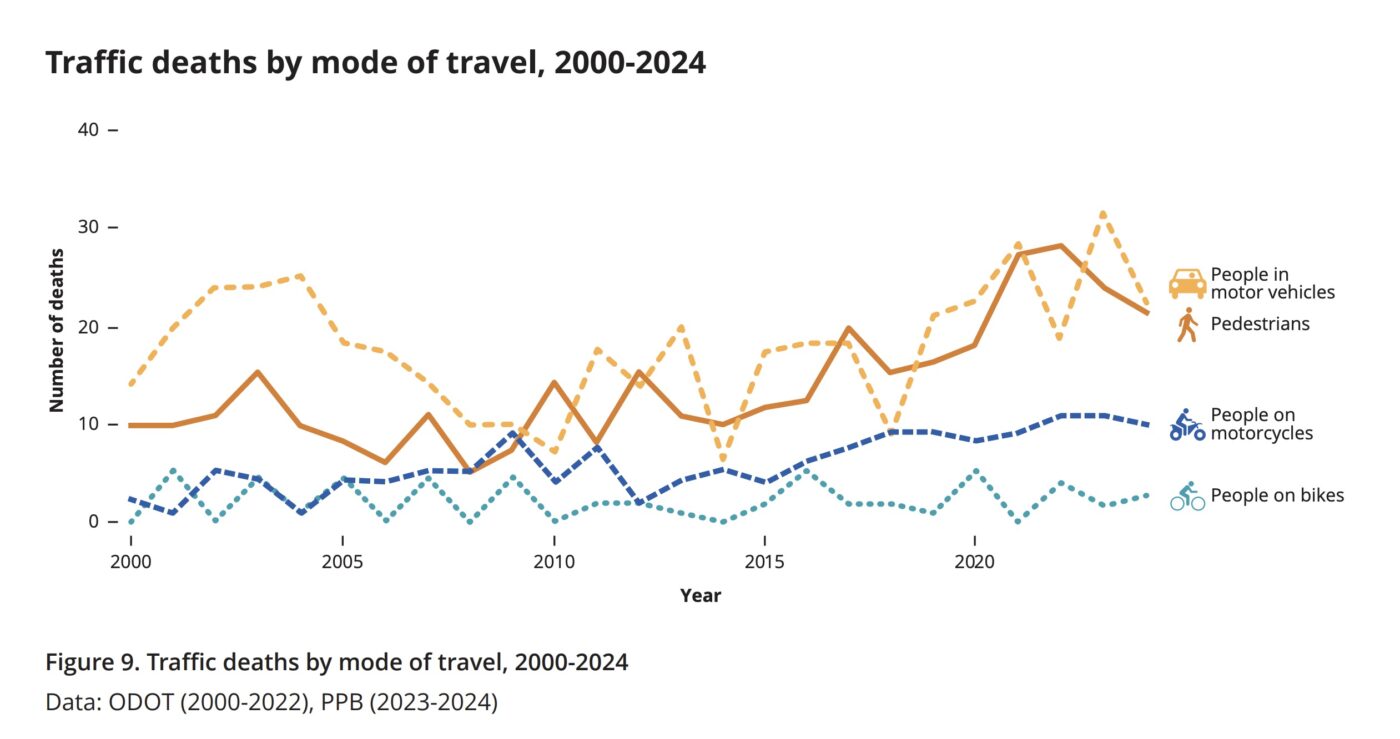
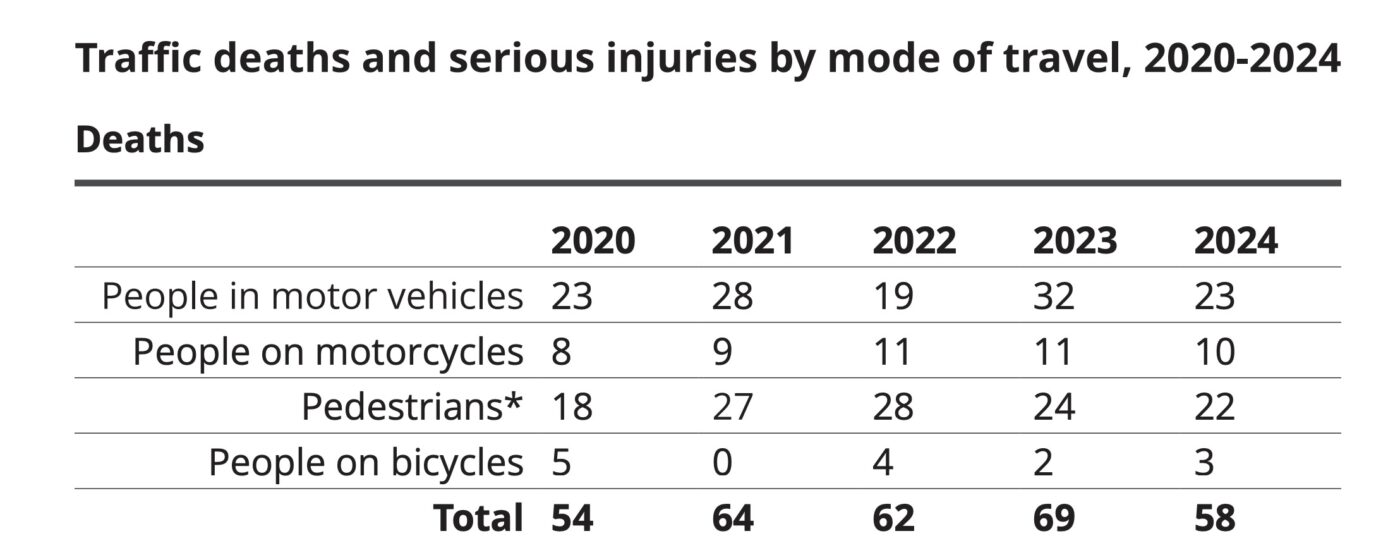
But before I share more from the report, a quick note about the fatality numbers is needed. PBOT’s number of 58 deaths differs from the tally recorded by the Portland Police Bureau (PPB) and from BikePortland’s Fatality Tracker. The PPB list includes 63 deaths (the list isn’t shared publicly, but I confirmed it via a public records request) and BikePortland’s list contains 67 names.
PBOT’s number is almost always lower because they adhere to National Highway Traffic Safety Administration (NHTSA) reporting criteria that excludes people who die under the following circumstances: more than 30 days after a crash; intentionally (by suicide); in an act of homicide (a person intentionally crashes into another person); in a crash not involving a motor vehicle (a MAX train and a pedestrian for example); from a prior medical event (like a heart attack or drug overdose); or a crash on private property (like a parking lot). The police use a bit more relaxed criteria and only exclude deaths by suicide or medical events (although this year, the PPB included one death that was initially reported as a medical event). (It’s an open — and important — debate as to why PBOT doesn’t embrace all road deaths publicly while staying consistent on the back-end with federal statistics; but I’ll save that discussion for another day.)
BikePortland’s list is the most comprehensive and it’s the only one available to the public in real time. I also cross-reference my list with the PPB and PBOT lists at the end of each year to make sure it’s accurate. OK, back to the story…
Much of what’s contained in PBOT’s latest report is the same movie we’ve seen before: Speeds and wide arterial streets are the big culprits. Quite simply, where there are big streets and high speeds, more people die. In 2024, 71% of deadly crashes occurred on what PBOT refers to as “High Crash Network streets,” which account for only 8% of Portland streets overall. And speeding was involved in nearly half (48%) of all fatal crashes last year.
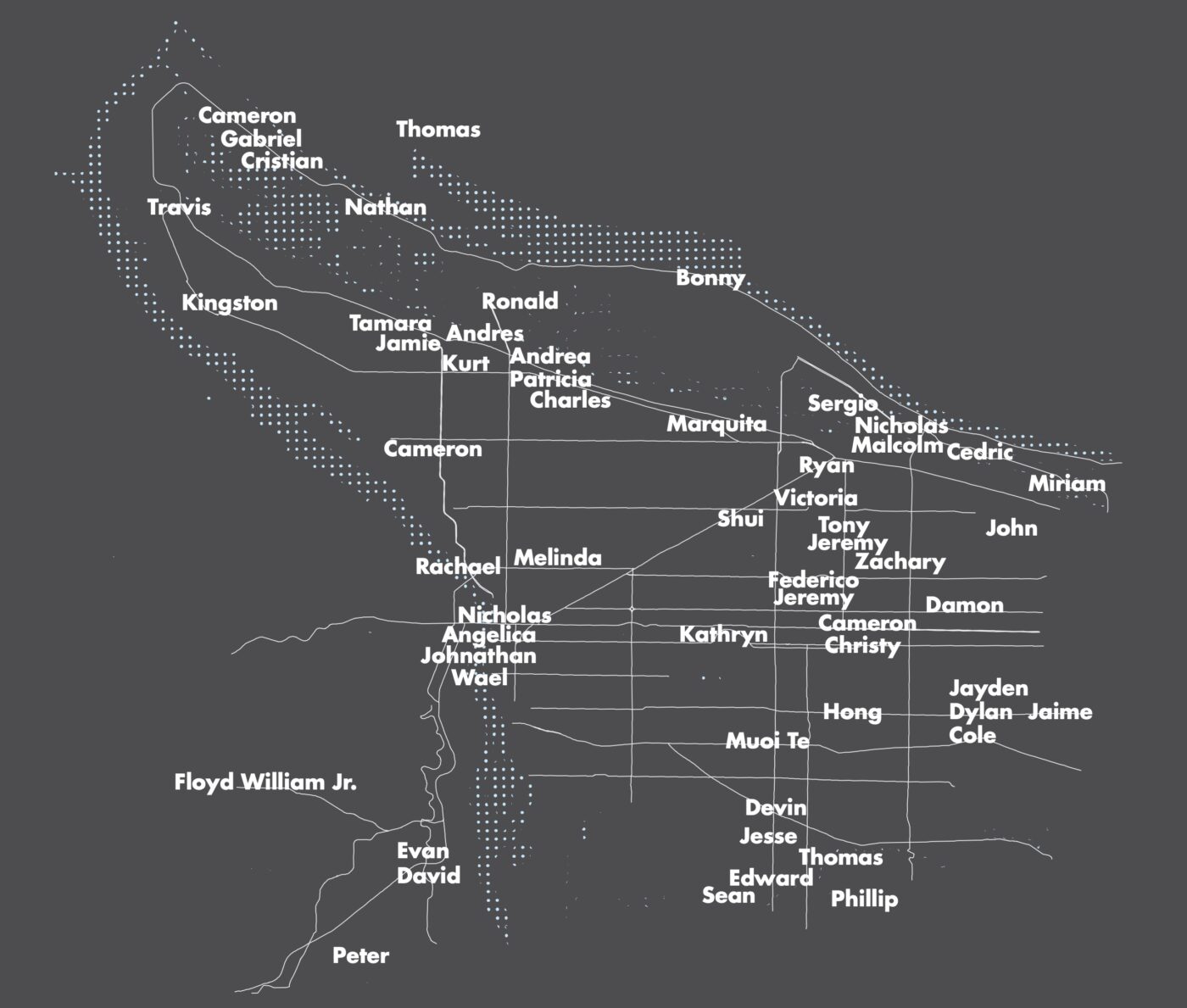
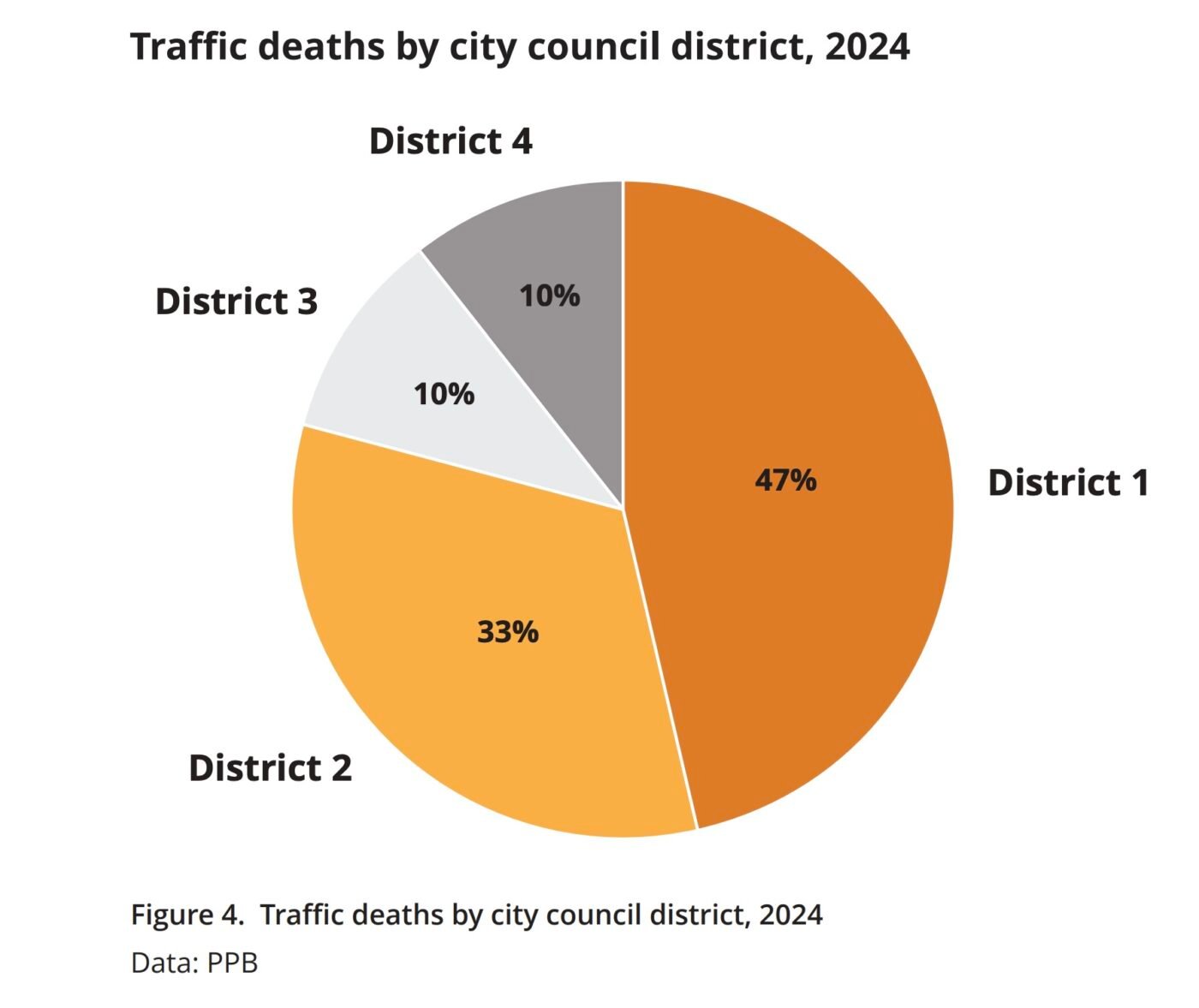
People speed on these “high crash” streets because the width gives them a false sense of security and a license to go fast. But they do so at all of our peril: 67% of the fatalities in Portland last year happened on streets with four or more travel lanes.
These stubborn facts are why PBOT works to narrow wide streets and why they’ve reduced dozens of speed limits citywide.
Changes like that can’t come soon enough for east Portland, where most of the city’s highest crash streets are intersections are located. In 2024, east Portland’s traffic death rate was 15 per 100,000 compared to six per 100,000 in the rest of the city. PBOT’s report also found that east Portland’s death rate remained the same as in 2023, while the rest of the city saw a decline.
A lack of light also plays a major role in road danger. In 2024, PBOT reports that 83% percent of traffic deaths occurred in nighttime conditions (dusk, night, and dawn). This year’s crash report was also the first time PBOT tallied data on vehicle size as part of their ongoing effort to fight the scourge of oversized trucks and SUVs. In 2024, 56% of the deaths to people walking and biking involved a collision with a large vehicle.
So while many people feel the goal of “Vision Zero” is unrealistic, if we just reduced driving space and speeds on major roads and invested in more street lights we could make immense progress relatively quickly.
But we can only control what we can control, and there are thorny outliers that will make reaching Vision Zero even more difficult.
A disturbing trend PBOT outlined in this year’s report is that youth deaths have spiked. Between 2015 and 2022 there were only about 1-3 people killed on Portland roads who were 18 years old or younger. But in 2024 (and 2023), that number rose to 7. PBOT says this is due in part to the increased popularity of speed racing and street takeovers.
In June, two teenagers (driver and a passenger) died while attempting to elude police in southeast Portland. A third teen who in the same car died two weeks later. In February, two teenagers died as their car crashed and burst into flames during a street race in northeast Portland. These tragedies — along with deaths to people who live on the street, people who use automobile traffic as a means for suicide, and people who are killed intentionally by someone driving a car — illustrate the urgent need to address our dysfunctional driving culture and myriad, underlying societal problems if we want to reach Vision Zero.
Regardless of why these deaths keep happening, the remedies will need to go through a political process. Now that we have geographic representation on Portland City Council for the first time ever, PBOT broke the fatalities down by district. In 2024, a plurality of traffic deaths (47% or 27 of 58) occurred in District 1, which includes east Portland. District 2 followed with 33% (19 of 58) of traffic deaths. Districts 3 and 4 each had 10% (6 of 58) of traffic deaths. The new slate of councilors has fully embrace the challenge of Vision Zero and it remains to be seen whether they will have a notable impact.
While 2024 continued grim trends, 2025 has been surprisingly quiet. So far this year there have been four traffic deaths. Last year we already had 15 deaths by this date — the lowest year-to-date total in many years. So while we haven’t met our first Vision Zero goal, Portlanders deserve nothing less than a continued commitment to save every life.




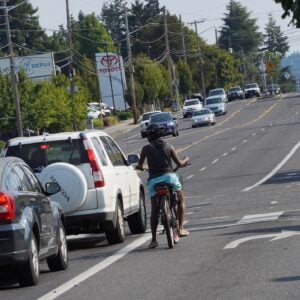
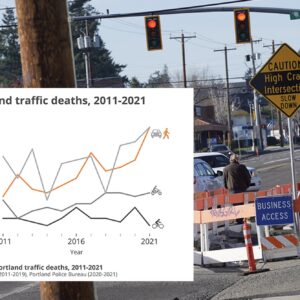

Thanks for reading.
BikePortland has served this community with independent community journalism since 2005. We rely on subscriptions from readers like you to survive. Your financial support is vital in keeping this valuable resource alive and well.
Please subscribe today to strengthen and expand our work.
From your headline photo, I’ve always felt that Portland ought to have a “ghost car” program, paint the wrecked cars white and place them upside-down on those large white-hatched gores around town. But no doubt there would be others who would rightly point out that the ghost cars would likely attract scrap parts thieves and even scrap dealers who might make off with entire wrecked cars late at night.
Wow I love that idea. Memorial sites are not enough. Leave the whole car
“Regardless of why these deaths keep happening, the remedies will need to go through a political process. Now that we have geographic representation on Portland City Council for the first time ever, PBOT broke the fatalities down by district. In 2024, a plurality of traffic deaths (47% or 27 of 58) occurred in District 1, which includes east Portland.”
JM, East Portland continues to work with the East Portland Action Plan (EPAP), East Portland In Motion (EPIM) plan, Division/Midway Streetscape plan and various other transportation plans in, and for, east Portland. Now we have representation in City Hall and someone on the Transportation and Infrastructure committee. There will be grades given.
While we continue to keep a modest amount of funding flowing from PBOT for help with Safe Routes To School, we’re still not able to do bike, or walking busses because of the lack of sidewalks around schools. Nor can we safely walk to the many business districts in east Portland.
I personally can’t get out of my neighborhood without having to use a High crash Intersection, or crossing a high Crash Corridor.
You also “had” Jo Ann Hardesty, who was in charge of PBOT, giving her far more power over transportation than anyone currently sitting on City Council.
It was the only time east Portland received 100% of per capita funding from PBOT. We subsidize the inner city’s transportation projects. We also subsidize BES improvements in the inner city.
Hey, remember when a few orange construction barrels immediately soothed four generations of gang violence? /s
Well, it’s now beyond clear that Vision Zero in Portland is officially dead. 🙁
Once again, the negative impacts of allowing/enabling unsanctioned street camping in our traffic violence crisis is swept under the rug. Is it not compassionate to keep people from living in unsafe conditions? We have building codes we enforce, why not camping codes?
Houseless campers aren’t responsible for their deaths by traffic violence, the cars are.
Doesn’t the question of responsibility depend on the particular circumstances of an individual incident?
No, the homeless are perennially blameless according to the activist class. Especially when they’re trespassing on ODOT property, crossing freeways on foot, intoxicated.
No. Death or injury by car is always the fault of the traffic system.
You know, I can’t even tell if this is serious or sarcastic because I know there are some folks here who actually believe this.
So if you’re under the influence of drugs or mentally ill, wander out of your tent at night and into a traffic lane and get hit…it’s the driver’s fault? Huh? Fortunately, our laws and courts do not agree with your statement.
Our species is 200,000 years old, cars are about a century old; death by this new tech is due to the tech. Our traffic systems need to adapt to people, not the other way around.
They are adapting, rapidly; in comparison to other transitions in the broad expanse of history you’ve evoked, automobiles are still brand new technology, and they’ve evolved quickly, becoming much safer in the brief time we’ve had them, and with robotaxis on the horizon, they’re likely to become much safer yet.
That’s just the fallacious techno-utopianism of the techno-fix (technologies to fix the harm created by other technologies) and the Myth of Progress.
That’s a lot of words to say something that is already working in the real world is a fantasy.
Besides, there is no other plausible social or legal changes on the horizon that will change the current status quo. Change is coming, ready or not.
Robotaxis are not change (see photo) and 40,000 U.S. deaths a year is not “working” for me.
Robitaxis could usher in the most significant transformation in transportation and urban structure in over a century. They are not killing 40,000 people a year, and could displace the human drivers who are, while at the same time greatly reducing the need for urban parking and urban pollution.
If that’s not “change”, I don’t know what is.
Rather than deny it is happening, we should be developing policies that channel that change to create the city we want.
If, for whatever reason, the technology does not pan out, we will likely be stuck with the current status quo indefinitely. That doesn’t sound good to me.
PS You posted an illustration that looks like I-5 today; It would represent a huge reduction in pollution if all those vehicles were electric.
I don’t share your enthusiasm for robotaxis.
And perhaps you weren’t around back then, but PBOT and a lot of local transportation activists thought automated vehicles would already be here and taking over by now. PBOT invested a lot of time and resources into the “Smart Autonomous Vehicle Initiative (SAVI)” plan that was adopted in 2017. But here we are 8 years later and the robotaxis haven’t arrived yet. Almost as if it’s just a capitalist fever dream pushed by car companies and tech bros!
Not in Portland, no. But in other cities, yes, and Waymo will be expanding to 10 more US cities this year (it’s available in 4 cities currently), and automated cars have been deployed in many more cities internationally.
Are we following the timelines suggested by breathless promotors in the initial phases of the hype cycle? No, of course not; we never do. And that’s probably good, because with something like this you want rollout to be very cautious and measured.
Do you really think the technology will not improve and get cheaper? Do you think it’s never going to reach Portland?
PS Do you know where I can find the city’s completed SAVI report? All I could find was a slideshow promoting it, and press releases saying the city was going to write one.
PPS I don’t consider myself a promoter, but it’s hard not to be a little enthusiastic about a technology that could save tens of thousands of American lives each year.
I don’t “follow” any timelines because, like you, I have healthy skepticism for this type of stuff.
But to me this isn’t just about a when/if. I just think it’s a terrible idea because many of the same negative externalities that exist with human-driven cars will remain with automated robo-cars. There’s not enough space to put them, they still need a power source, they will still create toxic microplastics from their tires, they will still hit and kill people, they will still destroy social fabric of communities, they will still contribute to bad public health outcomes, they will still be expensive to use and/or own, they will still be controlled by shitty corporations, and so on and so forth.
Another thing about this type of “new tech” is that it saps political urgency from other, proven, and much more urgent and necessary things like better bus service, rail service, bikeways, and so on.
Happy to be proven wrong but I don’t think robotaxis deserve much enthusiasm at this point.
Some will, yes, and it is likely that new problems will arise.
The question I think about are what are the range of plausible transportation futures. I see several, but all involve some sort of individualized motor vehicle remaining the primary mode of travel. I know many people here (including me) want a different future, but no one is able to make much of a case that it can actually happen. We could theoretically reorganize the city around mass transit and bicycling, but will we? Probably not, at least not in the time frame I consider interesting.
I agree that automated vehicles will compete directly with transit; they will likely offer a much higher level of service without many of the hassles. Even if they cost more than a bus ticket, we know people will be willing to pay (as they do today with Uber, which, I’m told, can sometimes be cheaper than renting a Biketown). I don’t know how that will play out, but I agree robotaxis seem likely weaken fixed route transit as a collective endeavor. (Personally, I don’t think our current transit system works all that well, even after decades and decades of trying to improve it, and, as many of the flaws are inherent in its design, I see no prospect for significant improvement without radical change.)
I hope we agree that robotaxis exist, and it seems quite likely that they are coming to Portland. It doesn’t matter what you think about that — it is just a fact about the world.
The question is how do we respond. How do we prepare for that likely future to ensure we create the most livable city possible?
That’s the crux of it. As the U.S. empire collapses, society’s unending (profit-friendly) high-tech “fix-it” fantasies, like robotaxis, will seem more and more obviously absurd.
There are easier, low-tech solutions to reducing traffic violence and death we should be pursuing.
It’s a fantasy you can live, today, for a few bucks if you’re in SF or LA or several other cities.
I agree, and we are pursuing them. You’re free to advocate for more radical low-tech solutions, but in order to actually implement them, they need to be affordable and politically palatable. If people generally hate your solution, it’s not of much value.
Meanwhile, the fantasy world continues its march.
Like A.I.; watch the speculative bubble burst before too long.
Interesting — I had a conversation with someone just yesterday who took that position. He described AI as a hollow promise that will punish every company that crapifies their products with it.
I said look what it can already do; according to several people I trust (Ezra Klein, Tyler Cowen, Kevin Rouse), the latest offering from OpenAI can produce research reports equivalent to what their professional teams can do in a week or two in just 5 minutes. It has already made important scientific breakthroughs (for example finding the 3D structure of every known protein), and finding a catalyst made from common materials for breaking apart water into H and O.
Maybe no one will figure out how to improve it further, but even what we have now will change a lot. If the tech continues to improve, as everyone seems sure it will, it’s hard to see how it would not be highly disruptive.
So sure, maybe it’s all speculative hype. But what I can use today (for free) seems so revolutionary that even that is a big deal.
I would contest the claims that new technology (it’s not clear if you are invoking OpenAI specifically or AI/ML generally) has found “the 3D structure of every known protein” or unknown water splitting catalysts that significantly improve on current technology. Are you referencing ML potentials for molecular dynamics? Or autonomous experimentation? Both these are indeed exciting and promising developments that could significantly advance science. But neither one is fundamentally dependent on AI, and I think it’s easy to overestimate the impact that scientific developments will have on consumer technology. When CRISPR was new it was going to change everything. In genetics, it has. For my everyday life, not so much. As for cars, will it really be that different if my taxi drives itself or an exploited member of the working class has to do it?
I was referring to AlphaFold (which was pretty big news when it came out, using the same self-learning techniques used by AlphaGo). The catalyst was from a lab that is automating the whole research stack, a promising approach that is still in its infancy. I understand “AI” to be the AI/ML field generally; ChatGPT is just one example of the incredible progress we’re seeing, and that we can all interact directly with.
Whether or not we achieve AGI (however defined), we’re achieving amazing advances today, and I (along with most observers) expect that to continue and accelerate. I don’t see any evidence at all that AI is just a bubble.
Yes — they will be safer and cheaper than a human driver. If they’re not, they won’t be deployed.
You haven’t been to Phoenix recently have you Jonathan? Waymos are everywhere.
https://matadornetwork.com/read/waymo-phoenix/
I think it’s extremely important to flag 5 young people were killed being pursued by the police in a police chase (and at least one innocent civilian injured). An outright ban on police chases is essential to reaching zero road fatalities
Some of those police chase-associated deaths were associated with crackdowns on street takeovers. Perhaps the cycling enthusiasts and urbanists who have supported these police crackdowns will consider the negative externalities of having thuggish police departments targeting kids and young adults.
https://www.kptv.com/2024/08/03/police-chase-ends-with-deadly-crash-ne-portland-during-street-takeover-crackdown/
Or maybe those folks can just pull over for the police.
So allowing dangerous street takeovers is really a good thing and helpful in promoting responsible behavior by our youth?
No, we just need an unarmed city employee to come out and ask them nicely to stop. That will solve it.
Ideally a PBOT employee, maybe one driving one of their little enforcementmobiles.
Perhaps if the city employed more police officers, they could better cordon the area around a street race. Then, instead of being chased, racers leaving the scene could merely be arrested at the cordon.
For the record, I wanted police intervention could go very bad. https://bikeportland.org/2021/03/09/opinion-theres-got-to-be-a-better-way-to-address-illegal-street-racing-327494
Yes, Jonathan you are.
Running away from the police should be banned.
it is banned. That’s what the law says at least.
We should stop trying. It’s obvious it will never happen.
The first does not follow from the second. I agree that “zero” is not achievable, but I don’t think we should just accept the carnage.
Every time I see a story like this, I wonder why we don’t also include the number of injuries caused by drivers. The focus on deaths is understandable—it’s the most dramatic and tragic outcome, obviously—but tracking nonfatal injuries, IMO, is important too, if we want a clear, full picture of the toll taken by traffic violence.
I agree Mark. I left out serious injuries on this story just for clarity and conciseness. But PBOT does track them so the numbers are there and I will continue to mention them in future stories.
Thanks, Jonathan. For the record, I wasn’t trying to single out Bike Portland here. It’s a widespread thing.
I would point out another benefit of tabulating injuries: more injuries occur, so the statistics associated with injuries will have larger sample sizes and be more definitive.
I’ll bet a lot of injuries go untabulated.
That’s an interesting suggestion: fluctuations in the efficiency of detecting nonfatal injuries could overwhelm the the gains from increased sample size (or to put it differently, one might obtain the best statistics from to total data set by filtering out nonfatal injuries to produce a ‘cleaner’ set that gives better statistics despite being smaller). I would also worry that the reporting/detection of nonfatal traffic injuries could become politicized–some actors might try to affect the statistics by selective nonreporting.
Another issue is that I’ll bet very few bike injuries get into the system, even ones resulting in broken bones or concussions. That might skew the data towards more “collection-friendly” incidents like car crashes that often result in a police response.